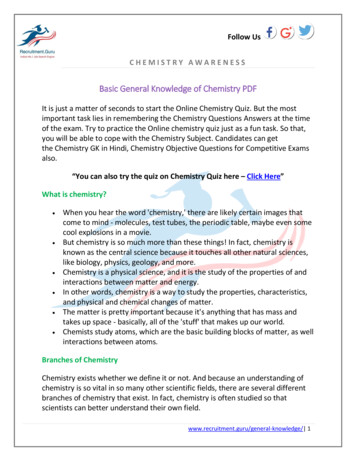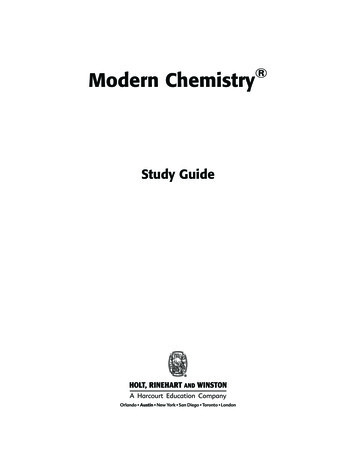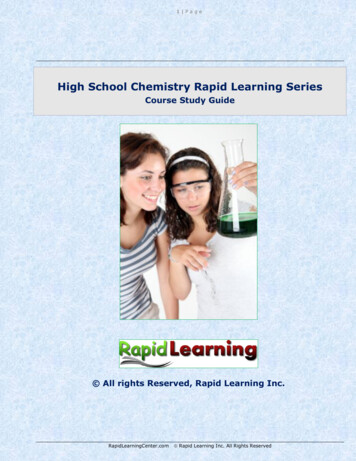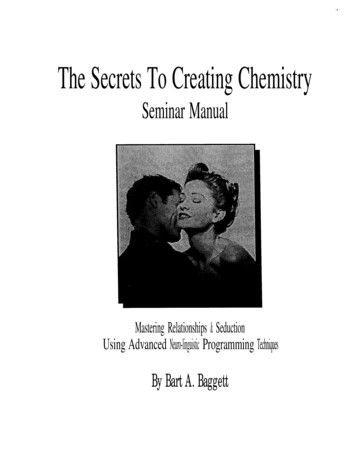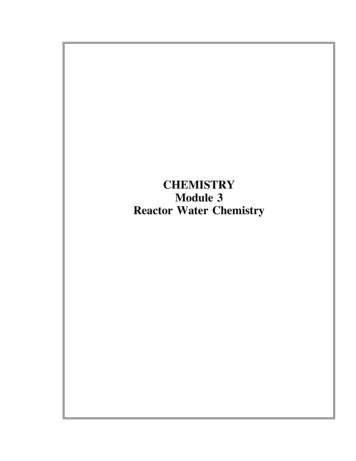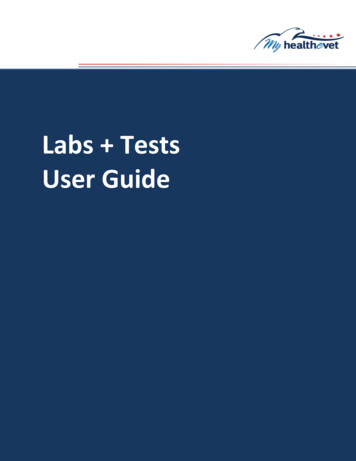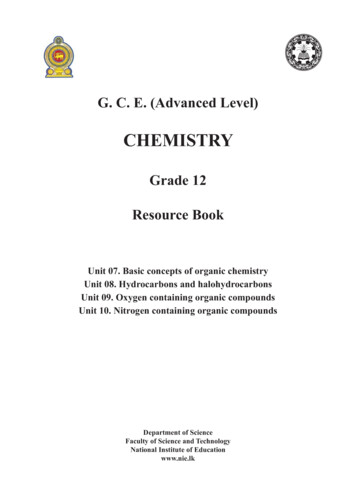
Transcription
G. C. E. (Advanced Level)CHEMISTRYGrade 12Resource BookUnit 07. Basic concepts of organic chemistryUnit 08. Hydrocarbons and halohydrocarbonsUnit 09. Oxygen containing organic compoundsUnit 10. Nitrogen containing organic compoundsDepartment of ScienceFaculty of Science and TechnologyNational Institute of Educationwww.nie.lk
ChemistryResource BookGrade 12 National Institute of EducationFirst Print – 2019Department of ScienceFaculty of Science and TechnologyNational Institute of EducationSri LankaPrinted by:PressNational Institute of EducationMaharagamaSri Lanka
Message from the Director GeneralThe National Institute of Education takes opportune steps from time to time for the developmentof quality in education. Preparation of supplementary resource books for respective subjects isone such initiative.Supplementary resource books have been composed by a team of curriculum developers of theNational Institute of Education, subject experts from the national universities and experiencedteachers from the school system. Because these resource books have been written so that theyare in line with the G. C. E. (A/L) new syllabus implemented in 2017, students can broadentheir understanding of the subject matter by referring these books while teachers can refer themin order to plan more effective learning teaching activities.I wish to express my sincere gratitude to the staff members of the National Institute of Educationand external subject experts who made their academic contribution to make this materialavailable to you.Dr. (Mrs.) T. A. R. J. GunasekaraDirector GeneralNational Institute of EducationMaharagama.iii
Message from the DirectorSince 2017, a rationalized curriculum, which is an updated version of the previous curriculum isin effect for the G.C.E (A/L) in the general education system of Sri Lanka. In this new curriculumcycle, revisions were made in the subject content, mode of delivery and curricular materials ofthe G.C.E. (A/L) Physics, Chemistry and Biology. Several alterations in the learning teachingsequence were also made. A new Teachers’ Guide was introduced in place of the previousTeacher’s Instruction Manual. In concurrence to that, certain changes in the learning teachingmethodology, evaluation and assessment are expected. The newly introduced Teachers’ Guideprovides learning outcomes, a guideline for teachers to mould the learning events, assessmentand evaluation.When implementing the previous curricula, the use of internationally recognized standardtextbooks published in English was imperative for the Advanced Level science subjects. Dueto the contradictions of facts related to the subject matter between different textbooks andinclusion of the content beyond the limits of the local curriculum, the usage of those bookswas not convenient for both teachers and students. This book comes to you as an attempt toovercome that issue.As this book is available in Sinhala, Tamil, and English, the book offers students an opportunityto refer the relevant subject content in their mother tongue as well as in English within thelimits of the local curriculum. It also provides both students and teachers a source of reliableinformation expected by the curriculum instead of various information gathered from the othersources.This book authored by subject experts from the universities and experienced subject teachers ispresented to you followed by the approval of the Academic Affairs Board and the Council of theNational Institute of Education. Thus, it can be recommended as a material of high standard.Dr. A. D. A. De SilvaDirectorDepartment of Scienceiv
A Note to Students from the AuthorsThis book has been written to specifically cover the contents of the Organic Chemistry unitsof the G.C.E. (A/L) Chemistry syllabus. The core content of the syllabus is concerned withthe characteristic reactions of selected classes of compounds. Modern Organic Chemistry isfounded on the basic idea that the chemical behavior of a compound can be accounted for byits structure. The book emphasizes the application of a limited number of fundamental conceptsto rationalize and understand all the reactions covered. Simple descriptions of mechanisms aregiven and explained where relevant. Only the reactions specified in the syllabus are covered, andfor any given reaction only the main product/products are considered. Experimental conditionsare given only if they are critical.The authors hope that the book will be useful to students to understand and appreciate organicchemistry, and to move away from rote memorization of isolated facts. This will build a solidfoundation for more advanced study if the student wishes to do so.v
GuidanceDr. (Mrs.) T. A. R. J. GunasekaraDirector GeneralNational Institute of EducationSupervisionDr. A. D. A. De SilvaDirector, Department of ScienceNational Institute of EducationMr. R. S. J. P. UduporuwaFormer Director, Department of ScienceNational Institute of EducationSubject LeaderMrs. M. S. WickramasingheAssistant Lecturer, Department of ScienceNational Institute of EducationInternal Editorial PanelMr. L. K. WadugeSenior Lecturer, Department of ScienceMrs. G. G. P. S. PereraAssistant Lecturer, Department of ScienceMr. V. RajudevanAssistant Lecturer, Department of ScienceWriting PanelEmeritus Professor of Chemistry,University of Sri JayewardenepuraProf. A. M. Abeysekara-Prof. G. M. K. B. Gunaherath-Senior Professor of Chemistry and Deputy ViceChancellor, The Open University of Sri LankaProf. Vajira Bulugahapitiya-Professor, Department of Chemistry,University of RuhunaProf. S. P. DeraniyagalaProf. M. D. P. De CostaExternal Editorial Panel- Senior Professor, Department of Chemistry,University of Sri Jayewardenepura- Senior Professor, Department of Chemistry,University of ColomboMr. K. D. Bandula Kumara- Deputy Commissioner, Education PublicationDepartment, Ministry of EducationMrs. Muditha Athukorala- SLTS-1, Prajapathi Balika Vidyalaya, Horanavi
Miss. C. A. N. Perera-SLTS-1, Princess of Wales’, MoratuwaMrs. V. K. W. D. Salika Madavi-SLTS-1, Muslim Ladies College, Colombo 04Mrs. H. M. D. D. D. Manike-SLTS-1, Viharamahadevi BalikaVidyalaya,KiribathgodaMrs. Deepika Nethsinghe-SLTS-1 (Rtd), Ladies College, Colombo 07Mr. S. Thillainathan-SLTS-1 (Rtd), Hindu Ladies College, Colombo 06Miss. S. Veluppillai-SLTS-1 (Rtd), Hindu Ladies College, Colombo 06Mrs. M. Thirunavukarasu-SLTS-1 (Rtd), Hindu Ladies College, Colombo 06Mrs. S. Rajadurai-SLTS-1 (Rtd), St. Peters' College, Colombo 04Language EditingMr. M. A. P. MunasingheChief Project Officer (Rtd.), National Institute of EducationCover PageMrs. R. R. K. PathiranaTechnical Assistant, National Institute of EducationSupporting StaffMrs.PadmaWeerawardanaMr. MangalaWelipitiyaMr. Ranjith DayawansaPrinting and Technology ManagementMr. W. M. U. Wijesooriya,Act. Director (Printing and Publication) - N.I.EPage Layout & Colour SeparationMrs. A. D. Anusha Tharangani.Computer Graphic Designer - N.I.Evii
ContentMessage from the Director General . . Message from the Director . .A note to students from the authors . .Team of resource persons . . . . .iiiivvviUnit 71.11.1.1Basic concepts of organic chemistry . . 1-25Organic chemistry in day to day life . . . . 02Why carbon can form a large number of organic compounds with vast structuraldiversity? Uniqueness of .2.1.61.2.1.71.2.1.8Diversity of organic compounds in terms of functional groups . . Classes of compounds with functional groups containing heteroatomsAlcoholEthersAldehydeKetonesAlkyl halidesCarboxylic acidsAcid halides, esters and amides (derivatives of carboxylic acids)Amines1.31.3.11.3.21.3.31.3.41.3.51.3.6IUPAC nomenclature of organic compounds. . . 07IUPAC NomenclatureAlkane hydrocarbonsNomenclature of branched chain alkanesNomenclature of alkene and alkyne hydrocarbonsIUPAC nomenclature of compounds other than hydrocarbonsIUPAC nomenclature of compounds containing more than one functional group1.41.4.11.4.2Isomerism . .Constitutional (structural) isomerismStereoisomerismUnit 82.1Hydrocarbons and halohydrocarbons . . . 26-52Structure, physical properties and nature of bonds of aliphatichydrocarbon . 27Properties of alkanesStructure of alkanesProperties of alkenes and alkynesStructure of alkenesStructure of alkynes2.1.12.1.22.1.32.1.42.1.50321
l reactions of alkanes, alkenes and alkynes in terms of theirstructures .Reactions of alkanesChlorination of alkanesReactions of alkenesAddition of hydrogen halides (HCl, HBr or HI)Addition of bromine to alkenesAddition of sulphuric acid and the hydrolysis of the addition productCatalytic addition of hydrogen (Hydrogenation)Reaction of alkenes with cold, alkaline, dilute potassium permanganateReactions of alkynesAddition of bromineAddition of hydrogen halidesAddition of waterCatalytic addition of hydrogen (Hydrogenation)Acidic nature of alkynes with terminal hydrogen2.32.3.12.3.2The nature of bonding in benzene . . . . Structure of benzeneStability of 2.4.3Characteristic reactions of benzene exemplifying its stability . .Electrophilic substitution reactions of benzeneNitrationFriedel - Crafts alkylationFriedel - Crafts acylationHalogenationResistance of benzene ring towards oxidationResistance of benzene ring towards hydrogenation442.52.5.12.5.2Directing ability of substituent groups of mono substituted benzene . .Ortho para directing groupsMeta directing groups492.6Structure and reactions of alkyl halides . . . .492.7Nucleophilic substitution reactions of alkyl halides in terms of thetiming of bond making and bond breaking steps . .51Unit 93.13.1.13.1.23.1.33.1.3.13.1.3.233Oxygen containing organic compounds . . . . 53-73Structure, properties and reactions of alcohols . . 54Classification of monohydric alcoholsPhysical propertiesReactions of alcoholsReactions involving cleavage of O-H bondNucleophilic substitution reactions involving cleavage of C-O bondx
3.1.3.3 Elimination reaction3.1.3.4 Oxidation of alcohols3.23.2.13.2.23.2.3Structure, properties and reactions of phenols .Acidity of phenolsReactions involving cleavage of the O-H bondNon-occurrence of nucleophilic substitution reactions by breaking C-O bond583.33.3.13.3.2Reactivity of the benzene ring in phenols .Reaction of phenol with Br2Nitration of .43.4.5Structure, properties and reactions aldehydes and ketones . . .60Physical propertiesReactions of aldehydes and ketonesNucleophilic addition reactionsAddition of HCN to aldehydes and ketonesReaction with Grignard reagentsReaction with 2,4-dinitrophenyl hydrazine (2,4-DNP or Brady reagent)Self-condensation reactions of aldehydes and ketonesReduction of aldehydes and ketones by lithium aluminium hydride (LiAlH4)or sodium borohydride (NaBH4)3.4.6Reduction of aldehydes and ketones by Zn(Hg)/conc. HCl (Clemmensonreduction)3.4.7Oxidation of aldehydes3.4.7.1 Oxidation by Tollens reagent3.4.7.2 Oxidation by Fehling solution3.4.7.3 Oxidation by acidified potassium dichromate or acidified chromic oxideor acidified potassium permanganate3.53.5.13.5.2Structure properties and reactions of carboxylic acids . .Physical propertiesComparison of the reactivity pattern of -COOH group with C O group inaldehydes and ketones and -OH group in alcohols and phenols3.5.2.1 Reactions involving cleavage of the O–H3.5.2.2 Reactions involving cleavage of the C–O bond3.5.2.3 Reduction of carboxylic acids with .6.2.170Reactions of carboxylic acid derivatives . .Reactions of acid chlorideReaction with aqueous sodium hydroxideReaction with waterReaction with alcohols and phenolsReaction with ammonia and primary aminesReactions of estersReaction with dilute mineral acidsxi
3.6.2.2 Reaction with aqueous sodium hydroxide3.6.2.3 Reaction with Grignard reagent3.6.2.4 Reduction by LiAlH43.6.3Reactions of amides3.6.3.1 Reaction with aqueous sodium hydroxide3.6.3.2 Reduction with LiAlH4Unit trogen containing organic compounds . . 74-80Structure, properties and reactions of primary amines and aniline .75Classification of aminesReactivity of the benzene ring of anilineReactions of primary aminesReaction of amines with alkyl halidesReaction of amines with aldehydes and ketonesReaction of amines with acid chlorideReaction of amines with nitrous acid (NaNO2/HCl)4.24.2.14.2.24.2.3Basicity of amines . .Basicity of amines versus alcoholsBasicity of primary aliphatic amines and anilineBasicity of amines compared to 3.2Reactions of aromatic diazonium salts . . 78Reactions in which the diazonium group is replaced by another atom or a groupReaction of diazonium salts with waterReaction of diazonium salts with hypophosphorous acid (H3PO2)Reaction of diazonium salts with CuCl and CuBrReaction of diazonium salts with CuCNReaction of diazonium salts with KIReactions in which the diazonium ion acts as an electrophilexii77
G.C.E. (A/L) CHEMISTRY: UNIT 7 Basic Concepts of Organic Chemistry1. Basic Concepts of Organic 1.31.2.1.41.2.1.51.2.1.61.2.1.71.2.1.8Organic chemistry in day to daylifeWhy carbon can form a largenumber of organic compounds withvast structural diversity? Uniquenessof carbonDiversity of organic compounds interms of functional groupsClasses of compounds withfunctional groups lkyl halidesCarboxylic acidsAcid halides, esters and amides(derivatives of carboxylic 4.11.4.21IUPAC nomenclature of organiccompoundsIUPAC nomenclatureAlkane hydrocarbonsNomenclature of branched chainalkanesNomenclature of alkene and alkynehydrocarbonsIUPAC nomenclature of compoundsother than hydrocarbonsIUPAC nomenclature of compoundscontaining more than one functionalgroupIsomerismConstitutional (structural) isomerismChain isomersPosition isomersFunctional group isomersStereoisomerismDiastereomerismEnantiomerism
G.C.E. (A/L) CHEMISTRY: UNIT 7 Basic Concepts of Organic ChemistryIntroductionOrganic Chemistry is the chemistry of compounds of carbon. In these compounds, carbon atomsform the skeleton or backbone of the molecule. In addition to carbon, organic compounds usuallycontain hydrogen. Oxygen, nitrogen, sulphur, phosphorus and halogens are also found in certainorganic compounds. These compounds can be natural or synthetic. Organic compounds forman essential component of all living organisms and play a central role in metabolic processes.Organic compounds also form an essential component in many of the materials that are essentialfor our daily life such as food, plastic items, textiles, cosmetics and medicines. The variety andnumber of compounds formed by carbon is very large compared to the compounds formed byother elements in the periodic table.1.1Organic chemistry in day to day lifeOrganic compounds are associated with nearly every aspect of our existence. For example:Food components: Carbohydrates, fats, proteinsPlastic materials: PVC, polythene, polystyrene, polyesters, nylonMedicines: Paracetamol, aspirin, penicillin, amoxicillinFuels: Petrol, diesel, kerosene, LP gas1.1.1 Why carbon can form a large number of organic compounds with vast structuraldiversity? Uniqueness of carbonCarbon-carbon and carbon-hydrogen bonds are the predominant bonds found in organiccompounds. Between two C atoms strong single bonds, double bonds and triple bonds can beformed. The small electronegativity difference between C and H also leads to the formation ofC–H covalent bonds. The presence of 4 electrons in its valence shell enables it to form 4 covalentbonds which include carbon-carbon double bonds and triple bonds. Due to these reasons, carbonis capable of forming linear and branched chains and rings leading to compounds with diversecarbon skeletons. As carbon can also form bonds with O, N, S, P and halogens, this leads tothe formation of an enormous variety of organic compounds having a wide range of molecularweights. When compared to Si which is also in the fourth group of the periodic table to whichC belongs, the C–C and C–H bonds possess higher bond energies than Si–Si and Si–H bonds.Some bond energies relevant to the discussion above are shown in Table 1.1.Table 1.1 Bond energies of some bonds with C and SiBondBond energy/ kJ mol‾1C–CC CC CC–HSi–SiSi–H3466108354132263182
G.C.E. (A/L) CHEMISTRY: UNIT 7 Basic Concepts of Organic Chemistry1.2Diversity of organic compounds in terms of functional groupsSome organic compounds contain only C and H as the constituent elements. They are knownas hydrocarbons. On the basis of the structure, hydrocarbons are divided into two main groupscalled aliphatic and aromatic. Hydrocarbons consisting of only open carbon chains are calledas acyclic aliphatic hydrocarbons while those with cyclic carbon chains are called alicyclichydrocarbons. The aliphatic hydrocarbons are classified as alkanes, alkenes, and alkynes. Thecyclic organic compounds which are stabilized by forming a cyclic delocalized cloud of πelectrons are called aromatic compounds. Benzene which is indicated by the molecular formulaC6H6 is the simplest of aromatic hydrocarbon compounds. The classification of hydrocarbons isshown in the Figure 1.1 with common examples of each type.Figure 1.1 Classification of hydrocarbonsNote: Cycloalkanes, cycloalkenes and cycloalkynes are not included in the currentG.C.E. (A/L) syllabus.Compounds are classified according to the functional groups present in their molecules. Afunctional group is a group of atoms in a molecule where most of its reactions take place.Apart from the carbon-carbon double bond and carbon-carbon triple bond, a functional groupcontains one or more heteroatoms such as nitrogen and oxygen. Common functional groups andthe names of the corresponding homologous series are given in Table 1.2.3
G.C.E. (A/L) CHEMISTRY: UNIT 7 Basic Concepts of Organic ChemistryTable 1.2 Functional groups in organic compoundsFunctionalgroupName of the homologousseriesExample with nameAlkeneHHC CHCH3propeneC CAlkyneH C C HethyneOHAlcoholCH3CH2 OHethanolOCHAldehydeOCKetoneC COCO HOCXOCO RR1 OR2ethanalCH3OCHpropanoneCH3OCCH3ethanoic acidCH3OCO HCH3OCClCarboxylic acidAcidhalideX Cl; acidchlorideX Br; acidbromideEsterOCH3 CO CH3EtherCH3 OCH2CH3OCNH2AmideOCH3 CNH2R2R1 NR3AmineCH3CH2 NH2C NNitrileXAlkylhalideCH3CH2 NHCH3X Cl; alkylchlorideX Br; alkylbromideX I; alkyl iodideethanoyl chloridemethyl ethanoateethylmethyl etherethanamideethylamineethylmethylamineCH3CH2 C NpropanenitrileCH3CH2 ClchloroethaneCH3CH2 BrbromoethaneNote: Alkenes, alkynes, ethers and alkyl halides are not considered as functional groups inthe IUPAC nomenclature system.4
G.C.E. (A/L) CHEMISTRY: UNIT 7 Basic Concepts of Organic Chemistry1.2.1 Classes of compounds with functional groups containing heteroatoms1.2.1.1 AlcoholAlcohols are compounds containing a hydroxyl group (–OH) attached to an alkyl group. Someexamples are given in Figure 1.2.Figure 1.2 Some examples for alcoholsNote: An alkyl group is formally derived from an alkane by the removal of a hydrogen atom.1.2.1.2 EthersEthers are compounds containing an oxygen atom attached to two alkyl groups. Some examplesare given in Figure 1.3.Figure 1.3 Some examples for ethers1.2.1.3 AldehydeAldehydes are compounds containing a carbonyl (C O) group attached to an H atom. Someexamples are given in Figure 1.4.Figure 1.4 Some examples for aldehydes1.2.1.4 KetonesKetones are compounds containing a carbonyl (C O) group attached to two carbon atoms eachof which may belong to an alkyl or aryl group. Some examples are given in Figure 1.5.Figure 1.5 Some examples for ketones5
G.C.E. (A/L) CHEMISTRY: UNIT 7 Basic Concepts of Organic Chemistry1.2.1.5 Alkyl halidesAlkyl halides are compounds containing a halogen atom bonded to an alkyl group. Someexamples are given in Figure 1.6.CH3ICH3CH2Brmethyl iodideethyl bromideClCH3CHCH3iso-propyl chlorideFigure 1.6 Some examples for alkyl halidesNote: Compounds containing a halogen atom joined to an aromatic ring are called arylhalides.1.2.1.6 Carboxylic acidsCarboxylic acids are compounds containing the carboxylic acid (COOH) group. Some examplesare given in Figure 1.7.OCOCH3 COHacetic acidOH COHformic acidOHbenzoic acidFigure 1.7 Some examples for carboxylic acids1.2.1.7 Acid halides, esters and amides (derivatives of carboxylic acids)Acid halides are compounds containing the COX group where X is a halogen atom. Esters arecompounds containing the COOR group and amides are compounds containing the CONH2group. Some examples are given in Figure 1.8.OCH3 CClacetyl chlorideOCH3 COCH2CH3ethyl acetateOCH3 CNH2acetamideFigure 1.8 Some examples for derivatives of carboxylic acidsNote: Acid halides, esters and amides are derived by replacing the OH group in the COOHgroup by halogen, OR and NH2 groups respectively.1.2.1.8 AminesAmines are compounds derived formally from ammonia by replacing its H atoms either byalkyl groups or aryl groups. Some examples are given in Figure ethylaminetrimethylamineFigure 1.9 Some examples for amines6NH2aniline
G.C.E. (A/L) CHEMISTRY: UNIT 7 Basic Concepts of Organic Chemistry1.3IUPAC nomenclature of organic compoundsThe set of rules for systematic nomenclature of organic compounds which is now in practiceevolved through several international conferences and are known as International Union ofPure and Applied Chemistry rules (IUPAC rules). Therefore, this system of nomenclature iscalled the IUPAC nomenclature system. In addition to the IUPAC nomenclature many commonorganic compounds are known by trivial (non-systematic) names. Some examples are given atthe end of this section.1.3.1 IUPAC nomenclatureThe IUPAC nomenclature system is governed by a large number of rules. In our discussion wewill limit ourselves to understand the most important ones which can be used to name morecommon types of organic compounds. The most important feature of the IUPAC system wouldbe that it will allow us to give one name to a given organic compound and to write only onestructure for a given IUPAC name.In this system, all the compounds with heteroatoms such as O, N, halogen, are consideredto be derived from the corresponding hydrocarbon. Therefore, as a start, let us look at howhydrocarbons are named according to the IUPAC system of nomenclature.1.3.2 Alkane hydrocarbonsAll the names of saturated hydrocarbons end with the suffix -ane. The stem of the hydrocarbonname denotes the number of carbon atoms present in the longest carbon chain. Learning thestems is like learning to count in Organic Chemistry. Stem names up to 6 carbon atoms aregiven in Table 1.3.Table 1.3 Stem names of hydrocarbons having up to six carbon atomsCarbon Number Stem nameName 2CH2CH3Before we consider little more complex hydrocarbons, let us look at how we can namealkyl groups.When we formally remove a H atom from an alkane an alkyl group is obtained. The name of analkyl group ends with the suffix -yl. When the terminal H atom of an unbranched hydrocarbonis removed the unbranched alkyl group is formed. Some examples are given in Table 1.4.7
G.C.E. (A/L) CHEMISTRY: UNIT 7 Basic Concepts of Organic ChemistryTable 1.4 Some examples of alkyl groupsHydrocarbonAlkyl .3.3Nomenclature of branched chain alkanesBranched chain alkanes can be considered the hydrocarbons which have alkyl groups attachedto its longest carbon chain. Let us go through the steps involved in naming of branched chainalkanes taking the following examples.Step 1. Identify the longest continuous chain of carbon atoms and derive the hydrocarbonname.5 Carbon atoms – pentane6 C atoms - hexaneNote: A methyl group is attached to one of the C atoms of compound 1 and an ethyl groupis attached to one of the C atoms of compound 2. A group that replaces an H atom of thehydrocarbon chain is called a substituent group. Therefore methyl group in compound 1 andethyl group in compound 2 are substituents.Step 2. Number the carbon atoms of the longest continuous carbon chain such that the C atombearing the substituent group gets the lowest possible number.8
G.C.E. (A/L) CHEMISTRY: UNIT 7 Basic Concepts of Organic ChemistryNote: The carbon chain of compound 1is numbered from right to left. If the carbon chain of thiscompound is numbered from left to right, the carbon atom to which the methyl group is attachedwill be assigned number 4 which is a higher number than 2.Step 3. Use the number obtained by applying the above step (2) to designate the location ofthe substituent. Write the name of the compound by placing the hydrocarbon name (name ofthe parent hydrocarbon) at last preceded by the substituent group with the number designatingits location. Numbers are separated from words by a hyphen while numbers are separated bycommas.When two or more substituents are present they should get the lowest possible numbersdesignating their location on the longest carbon chain. The substituent groups should be placedalphabetically in the IUPAC name. Let us take two more CH2CCH2CH3CH3123 4Longest hydrocarbon chain Six - hexaneFive - pentaneSubstituents and theirlocation2-methyl, 4-ethyl3-methyl, 3-ethylIUPAC hen two or more substituents are identical, they are indicated by the prefixes, di- (2), tri(3), tetra- (4) etc. Every substituent should be given the number that shows its location on thelongest carbon chain.12345CH3CHCH2CHCH3CH3CH3CH31263 45CH3CH2CCH2CH2CH3CH3Longest hydrocarbon chain Five - pentaneSix - hexaneSubstituents and theirlocation2-methyl, 4-methyl3-methyl, 3-methylIUPAC name2,4-dimethylpentane3,3-dimethylhexane9
G.C.E. (A/L) CHEMISTRY: UNIT 7 Basic Concepts of Organic Chemistry1.3.4 Nomenclature of alkene and alkyne hydrocarbonsAlkenes contain carbon-carbon double bonds. According to IUPAC nomenclature, thesuffix -ane is replaced by suffix -ene in alkenes with the number designating thelocation of the double bond in the parent hydrocarbon. Let us go through the stepsinvolved in naming alkenes taking some examples.Step 1. Identify the longest continuous carbon chain including the carbon-carbon doublebond. Number the carbon chain such that the double bond carbons get the lowestpossible numbers.Step 2. Build the IUPAC name by placing the name representing the carbon number andsuffix -ene with the lowest number designated to the location of the double bond.34215CH3CH2CH CH2(3)3421CH3CH2CH CHCH3(4)Longest carbon chainFour - butFive – pentDouble bond location1,22,3IUPAC namebut-1-ene (1-butene)pent-2-ene (2-pentene)Step 3. When substituents are present, they are placed in as prefixes along with the numberdesignated to indicate their location in the longest carbon chain containing the double bond.54321CH3CHCH CHCH3CH3Longest carbon chainDouble bond locationParent hydrocarbon nameSubstituents with locationIUPAC name654321CH3CHCH2C CHCH3CH3 CH3Five - pent2,3pent-2-ene (2-pentene)4-methylSix - hex2,3hex-2-ene (2-hexene)3-methyl, dimethylhex-2-ene(3,5-dimethyl-2-hexene)If the double bond gets the same set of numbers when the chain is numbered from either sidesof the carbon chain, then the numbering should be done such that substituents get the lowestpossible numbers.10
G.C.E. (A/L) CHEMISTRY: UNIT 7 Basic Concepts of Organic Chemistry653421CH3CH2CH CHCHCH361234 5CH3Longest carbon chainDouble bond locationParent hydrocarbon nameSubstituents with locationIUPAC nameSix - hex3, 4hex-3-ene ene)654321CH3CH2C CHCHCH313 4562CH3 CH3Six - hex3, 4hex-3-ene (3-hexene)2-methyl, e)Alkynes contain carbon-carbon triple bonds. They are named by replacing suffix -ane of alkaneby suffix -yne. The rest follows similar to nomenclature of alkenes.123 45CH3C CCHCH3CH3Longest carbon chainTriple bond locationParent hydrocarbon nameSubstituents with locationIUPAC nameFive - pent2, 3pent-2-yne entyne)6543 21CH3CH2C CCHCH3CH3Six - hex3, 4hex-3-yne yne)Let us now summarize the basic principles of naming hydrocarbons according to the IUPACsystem. This will be the foundation for the naming of compounds containing functionalgroups.(i)All the compounds are considered to be derived from the hydrocarbon containing thelongest carbon chain.(ii)When a double bond or a triple bond is present, the longest carbon chain should bechosen to include the double bond or the triple bond.(iii) A suitable suffix (-ane, -ene or -yne) is added to the stem name which denotes thenumber of carbon atoms (parent hydrocarbon).(iv) When double bonds or triple bonds are absent, the carbon atoms carrying substituentsare given the lowest possible numbers.(v)When a double bond or a triple bond is present it is given the lowest possible number.(vi) Substituent names are
CHEMISTRY Grade 12 Resource Book Unit 07. Basic concepts of organic chemistry Unit 08. Hydrocarbons and halohydrocarbons Unit 09. Oxygen containing organic compounds Unit 10. Nitrogen containing organic compounds Department of Science Faculty of Science




